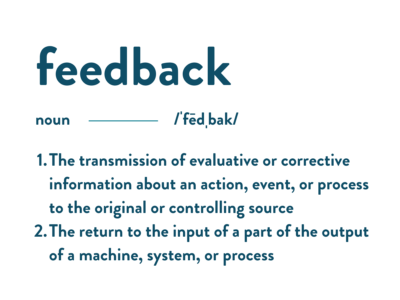Table of Contents
Books, like Dare to Lead by Brene Brown and Radical Candor by Kim Malone Scott, got folks invested in efforts to get or give feedback. However, getting, sharing, and responding to feedback can be much easier in concept than execution. And yet effective feedback systems are powerfully important – not just for individuals but also for organizations.
Possip Founder and CEO, Shani Dowell, shares insights on requesting and using feedback and why we consider it crucial for growth and progress.
Personal and organizational feedback drives developmental growth, improves performance, and saves time (no need to consternate when you know what people think).
So even though it’s hard, we’ve got to get over the hard. This essential guide to giving, listening, and responding to feedback can help.
Feedback Gets a Bad Rap
One of my teammates asked an interesting question in her first weeks at Possip: “We talk about feedback like it’s a presumed negative. But isn’t praise a form of feedback?” Even though positive (positive+gossip=possip) is in our name, her observation was a new insight.
Indeed! Praise is feedback. Sharing a need is feedback. Ideas, issues, and concerns are all feedback. Feedback encompasses the system or loop of sharing with a person, entity, or organization.
Here are some formal definitions of feedback according to Merriam-Webster.

Feedback doesn’t have to be bad. Sometimes, we automatically assume that when we invite feedback, we will hear from an angry person who is sharing a complaint. But consider these examples of feedback:
Example of Praise
- “Thank you for reaching out to close the loop after the last possip survey. I feel heard and that my concerns were addressed. Big shout out to Dr S, who has been very up front with all of my concerns and made sure to address them right away. Love that communication has increased and that I feel more connected to what my son is currently doing at school. Huge shout out to Dr. J, who truly cares for my child and ensures that all of his academic needs are met. Huge shout out to Ms. N, who has him in a social group, allowing him to form positive relationships with peers.”
- “Darles las gracias ya que cualquier cosa que tenga que ver con mi hija ustedes me lo an hecho saber de inmediato gracias ❤️ TRANSLATION: “Thank you because anything that has to do with my daughter you have let me know immediately, thank you ❤️
- “Professor F has really made me more excited about learning.”
Example of Needs
- “We need help with lunches and other costs”
- “I don’t know how to enroll my son, I don’t know when I should do it so he can go to high school.”
- “We need help filling out our FAFSA forms.”
Example of Ideas
- “I think the meetings we are having at the end of the day aren’t the most effective idea. If we had them earlier people would be in a better mind space to contribute.”
- “It would be great to get buses to away games so we can have more student spirit and support our teams. Maybe we can do some fundraisers for them.”
- The challenge with feedback can be that it’s often not solicited proactively. If it’s not requested, it can only be received reactively—typically from folks who have an issue. But there are many forms of feedback.
How to Ask for Feedback
The first step in getting holistic (not just negative) feedback: ask for it.
How? Create strong systems for asking for feedback. Getting feedback personally – or organizationally – means you need a way to ask for feedback that is:
- Routine
- Systematic
- Easy-to-digest
- Equitable
- Open-ended
When you are asking for feedback, put parameters into it. It’s okay to ask for feedback in ways you can handle it. For example, if you know you are one person trying to ingest feedback from tens of thousands of people, you may not be able to solicit open-ended feedback. But it’s important to explain the how and why for your feedback systems. At the very least, you can create routine and systematic ways to get feedback and communicate that with your community.
Possip has created an easy way for any organization to create a routine and systematic feedback loop. For higher-capacity organizations, you can ask for quantitative and qualitative feedback. For organizations developing in your capacity, you may decide only to do closed-ended feedback until you can handle more open-ended feedback. Meet with our specialists to learn the right approach for your team!
How to Give Effective Feedback
Unsolicited Feedback
Unsolicited feedback can be a bit trickier to give. But there’s one crucial step that can make it easy! Make it solicited or at least prepared for. So, the first step is to ask for permission to give feedback.
After you’ve asked for permission, there are general frames – but include:
- be kind;
- share the action and outcome/impact of the action;
- identify the ideal outcome.
Importantly, whether positive feedback or adjusting/constructive, ask for permission.
Focus on specific behaviors rather than personal attributes, and always aim to be constructive. When people deliver feedback with empathy and give clear, actionable thoughts, it becomes a gift that helps others grow. Here are three examples from a school context that are very relevant to a broader use case:
Solicited Feedback
When people request feedback, it immediately becomes easier to give than unsolicited feedback – because, ideally, it means there’s a system and structure for doing so. The only difference between solicited and unsolicited is how you create a culture of feedback that welcomes the conversation.
Here are a few other resources:
How to Listen to Feedback
Listening to feedback can be hard. It is natural to feel defensive or dismissive when you get feedback. It’s okay to start there – but don’t stay there. Here are a few tips.
Listening Essentials – Give yourself:
1 – A model or protocol for listening and digesting feedback.
Human nature is – well – natural. While you may be the superhuman who can get harsh feedback and not internalize it, that is not likely. A model or system to digest feedback, like the one from Howard University Middle School, can be helpful.
2 – Time!
I’ve been part of a few youth sports programs. They often have a 24-hour rule. This rule states that you don’t give feedback to a coach until 24 hours has passed from the game. Similarly, if a coach receives an angry email from a parent, they wait at least 24 hours to respond. You can review feedback once. It may bother you. But give yourself some distance. With time, you may even see the validity of the feedback and feel more prepared to solve the problem.
3 – Freedom from a solution.
Sometimes, the challenge isn’t the feedback. The challenge is the pressure of having a solution to the problem. When you free yourself from needing to come to a solution, you can spend more time understanding and empathizing with the problem. Possip offers our customers 360 Scripts because we know that communicating that you have heard your community is Step 1. Having the space to listen is Step 2. Having the opportunity to solve and respond is Step 3.
In an actual conversation, this is akin to Active Listening. Instead of listening to respond, you spend time truly listening to understand.
4 – The luxury of praise.
We often see customers breeze past the positive and transformational feedback they get. Don’t. Bask in the luxury of praise and the people who love you. Respect the time, effort, and opinions of the people who love your organization at least as much as you do the folks who have issues.
Getting the benefits of feedback means we have to listen with an open heart and mind and a willingness to learn. We have to get okay with a bruised ego, resist the urge to respond, and be patient – with ourselves and the feedback. We have to sit in the good, at least as much as we do the bad. And create a space so we as leaders and our team, can receive, reflect upon, and integrate feedback into future actions.
- Howard University MS’s Protocol for Using Family Feedback in School Improvement – Possip
- The Best School Boards Listen – Possip
- In a Time of Unrest, How Can College Students Feel Heard on Campus? – Possip
- The Path to Safer Schools: Top Questions to Ask – Possip
- 52 Effective Parent Survey Questions For Meaningful Feedback – Possip
How to Respond to Feedback That Makes People Feel Heard
It’s not enough to just listen; you need to acknowledge the feedback, thank the person for their input, and communicate the steps you plan to take. When people see that you value their feedback and that it leads to action, they feel heard and respected. This not only builds trust but also encourages a culture of continuous improvement.
How to Change the Game by Acting on and Listening to Feedback
Firstly, show in your outbound communication that – and how – you are listening: 6 Tips on How to Communicate to Listen and Hear (while this article discussed feedback in the context of schools, it applies to all).
The true power of feedback lies in how you use it to drive change. After gathering feedback and responding appropriately, implement changes that reflect the insights you’ve gained. This could mean adjusting processes, enhancing communication, or making other strategic shifts. By acting on feedback, you demonstrate a commitment to growth and improvement, creating a feedback loop that’s effective and transformative.
Conclusion
By creating systems to listen, effectively sharing and responding to feedback, and taking action, you can change the way you and your team perceive and use feedback. What will you do differently in your feedback loop? Start by embracing feedback as a tool for growth, and you’ll be well on your way to creating a culture of continuous improvement.
Speed Read of Your Essential Guide to Giving, Listening to, and Responding to Feedback

1. Why Feedback Systems Matter: Feedback helps personal and organizational growth. It offers praise, needs, and ideas, not just criticism. Effective feedback systems improve performance and save time.
2. Effective Feedback Systems: People and organizations need routine, systematic, and equitable feedback systems. Read why and how.
3. Responding to Feedback: Listening to feedback is hard and important. Give yourself time, space and grace to listen. Then, share back what you’ve heard. You have time to decide what, if any, changes you make. If and when you make changes, communicate back out.
Read below for resources, tips, and the why!


